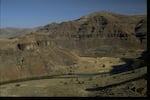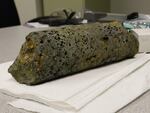
The Pacific Northwest is home to the Columbia River Basalt Group, a rock formation of interest for geologically storing carbon.
U.S. Department of Interior, Bureau of Land Management
If you can imagine the Pacific Northwest’s towering basalt formations as giant billboards for underground storage tanks, you’re thinking like a scientist.
At least you’re thinking like a few scientists who want to capture and store carbon dioxide (CO2) deep inside those rocks.
Some believe the underground option could be a safe way to handle the greenhouse gas, which traps the sun's heat within the earth’s atmosphere and contributes to climate change.
A relatively small experiment is underway near Wallula, Wash., where Pacific Northwest National Laboratory researchers have drilled a hole about three-quarters of a mile deep and are ready to inject CO2. But they need some money.
"Our contract with the Department of Energy has expired, and so we're in the process of redoing that. It takes a little while, but I think we'll be back on track toward the fall,” says Pete McGrail, an environmental engineer with PNNL.
Some fear that CO2 injection projects could present problems similar to those posed by hydraulic fracturing, or fracking, used by the natural gas drilling industry.
Ground water pollution becomes an issue whenever just about any kind of drilling is done.
Ashley Henry, who coordinates Climate Solutions’ Northwest Biocarbon Initiative, prefers a storage approach that takes advantage of plants, trees and soil, which already store CO2 as part of their natural process.
“We are concerned about the unintended consequences of geophysical engineering,” she says.
The Washington basalt formations include cap rocks that would keep the CO2 underground, says Gretchen Hund, a senior scientist with PNNL.
The first test will be small, she says, about 1,000 metric tons of CO2. That’s about 2.2 million pounds.
Basalt storage has become an attractive alternative because when CO2 reacts with basalt, the CO2 turns into a mineral-calcium carbonate, Hund said.
The hope is that in mineral form, the once-destructive CO2 would stay underground forever. That theory is a theory, and no one really knows how long it would take the CO2 to turn into mineral.
“Of course, there are many questions to answer before you begin pumping CO2 into the rock and charging money to do so,” says Oregon State Geologist Vicki McConnell.
For one, transporting the unwanted CO2 would require capturing it at the source. Electric power plants, cement plants, ethanol production and transmission operations, soda ash producers and military operations generate most of the Northwest's supply of unwanted CO2. Then, the CO2 has to be compressed to a liquid-like state and trucked or pumped through a pipeline, which would have to be built. States that inject CO2 to coax oil out of the ground already have the pipelines, but that's not happening in the Northwest.
In this area, Oregon has the least number of CO2 producers, but it has significant basalt resources. “In our case, the CRBG (Columbia River Basalt Group) covered almost half of Oregon 15 million years ago and is up to 10,000 feet deep in some areas,” McConnell said.
The CRBG also spreads across Washington and into Idaho.
Idaho’s carbon sequestration efforts focus mainly on using forests, croplands and grazing land. Both Oregon and Washington have been studying land-based solutions, too.
Still, underground injection work is part of a national strategy and has attracted federal research dollars. The Washington project falls under the auspices of the Big Sky Sequestration Partnership, based at Montana State University. Both Washington State University and Portland State University are listed as partners.
Another partner, Montana State University, recently announced the Big Sky Sequestration Partnership has $67 million in federal funds to begin an 8-year project to study CO2 injection into the Kevin Dome, a rock formation that already holds CO2. Scientist there think the dome can hold a lot more CO2. Their research may substantiate that hypothesis. They plan to inject 1 million tons of C02 a mile underground into the dome.
The elimination of environmental concerns depends heavily on understanding the geology of the test site, says Lee Spangler, director of the Big Sky Sequestration Partnership.
“The other thing is that CO2 is not highly toxic, so even if there were a small amount of leakage, which is improbable if the project is done properly, it doesn’t necessarily cause health or safety issues or environmental issues,” Spangler says.
It’s all about the geology, he says.
